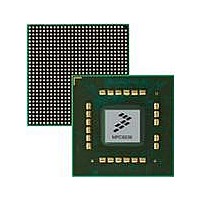MPC8536DS Freescale Semiconductor, MPC8536DS Datasheet - Page 1082

MPC8536DS
Manufacturer Part Number
MPC8536DS
Description
BOARD DEV SYSTEM MPC8536E
Manufacturer
Freescale Semiconductor
Series
PowerQUICC III™r
Type
MPUr
Datasheets
1.MPC8536EBVTAVLA.pdf
(127 pages)
2.MPC8536EBVTAVLA.pdf
(1706 pages)
3.MPC8536DS.pdf
(2 pages)
4.MPC8536DS.pdf
(126 pages)
Specifications of MPC8536DS
Contents
Board, Software and Documentation
Processor Series
MPC85xx
Core
e500
Data Bus Width
32 bit
Maximum Clock Frequency
667 MHz
Operating Supply Voltage
- 0.3 V to + 1.21 V
Maximum Operating Temperature
+ 105 C
Data Ram Size
32 KB
Interface Type
SPI, USB
Program Memory Type
DDR2, DDR3, SDRAM
Core Size
32 Bit
Program Memory Size
544KB
Cpu Speed
1.5GHz
Digital Ic Case Style
BGA
No. Of Pins
783
Supply Voltage Range
0.95V To 1.05V
Rohs Compliant
Yes
For Use With/related Products
MPC8536
Lead Free Status / RoHS Status
Lead free / RoHS Compliant
- MPC8536EBVTAVLA PDF datasheet
- MPC8536EBVTAVLA PDF datasheet #2
- MPC8536DS PDF datasheet #3
- MPC8536DS PDF datasheet #4
- Current page: 1082 of 1706
- Download datasheet (15Mb)
PCI Bus Interface
it asserts PCI_STOP, indicating that the target can accept the current data, but no more data can be
transferred. For disconnect-without-data, the target asserts PCI_STOP when PCI_TRDY is negated
indicating that the target cannot accept any more data.
16.4.2.9
Fast Back-to-Back Transactions
The PCI bus allows fast back-to-back transactions by the same master. During a fast back-to-back
transaction, the initiator starts the next transaction immediately without an idle state. The last data phase
completes when PCI_FRAME is negated, and PCI_IRDY and PCI_TRDY are asserted. The current
master starts another transaction in the clock cycle immediately following the last data transfer for the
previous transaction.
Fast back-to-back transactions must avoid contention on the PCI_TRDY, PCI_DEVSEL, PCI_PERR, and
PCI_STOP signals. There are two types of fast back-to-back transactions—those that access the same
target and those that access multiple targets sequentially. The first type places the burden of avoiding
contention on the initiator; the second type places the burden of avoiding contention on all potential
targets.
As an initiator, the PCI controller does not perform any fast back-to-back transactions. As a target, the PCI
controller supports both types of fast back-to-back transactions.
During fast back-to-back transactions, the PCI controller monitors the bus states to determine if it is the
target of a transaction. If the previous transaction was not directed to the PCI controller but the current
transaction is directed at the PCI controller, it delays the assertion of PCI_DEVSEL (as well as
PCI_TRDY, PCI_STOP, and PCI_PERR) for one clock cycle to allow the other target to stop driving the
bus.
16.4.2.10 Dual Address Cycles
The PCI controller supports dual address cycle (DAC) commands (64-bit addressing on PCI bus) as both
an initiator and a target. DACs are different from single address cycles (SACs) in that the address phase
takes two PCI beats instead of one PCI beat to transfer (64-bit vs. 32-bit addressing). Only PCI memory
commands can use DAC cycles; I/O, configuration, interrupt acknowledge, and special cycle command
cannot use DAC cycles. The PCI controller block supports single-beat and burst DAC transactions.
For the case of the local processor, DAC generation depends on the setting of the POTEARx. If the
POTEARx are programmed with nonzero values and a transaction from the local processor core hits in
one of the outbound windows, a DAC transaction is generated on the PCI bus with the translated lower
32-bit addresses. Refer to
Section 16.3.1.2, “PCI ATMU Outbound Registers,”
for more information.
MPC8536E PowerQUICC III Integrated Processor Reference Manual, Rev. 1
16-56
Freescale Semiconductor
Related parts for MPC8536DS
Image
Part Number
Description
Manufacturer
Datasheet
Request
R
Part Number:
Description:
Manufacturer:
Freescale Semiconductor, Inc
Datasheet:
Part Number:
Description:
Manufacturer:
Freescale Semiconductor, Inc
Datasheet:
Part Number:
Description:
Manufacturer:
Freescale Semiconductor, Inc
Datasheet:
Part Number:
Description:
Manufacturer:
Freescale Semiconductor, Inc
Datasheet:
Part Number:
Description:
Manufacturer:
Freescale Semiconductor, Inc
Datasheet:
Part Number:
Description:
Manufacturer:
Freescale Semiconductor, Inc
Datasheet:
Part Number:
Description:
Manufacturer:
Freescale Semiconductor, Inc
Datasheet:
Part Number:
Description:
Manufacturer:
Freescale Semiconductor, Inc
Datasheet:
Part Number:
Description:
Manufacturer:
Freescale Semiconductor, Inc
Datasheet:
Part Number:
Description:
Manufacturer:
Freescale Semiconductor, Inc
Datasheet:
Part Number:
Description:
Manufacturer:
Freescale Semiconductor, Inc
Datasheet:
Part Number:
Description:
Manufacturer:
Freescale Semiconductor, Inc
Datasheet:
Part Number:
Description:
Manufacturer:
Freescale Semiconductor, Inc
Datasheet:
Part Number:
Description:
Manufacturer:
Freescale Semiconductor, Inc
Datasheet:
Part Number:
Description:
Manufacturer:
Freescale Semiconductor, Inc
Datasheet:










